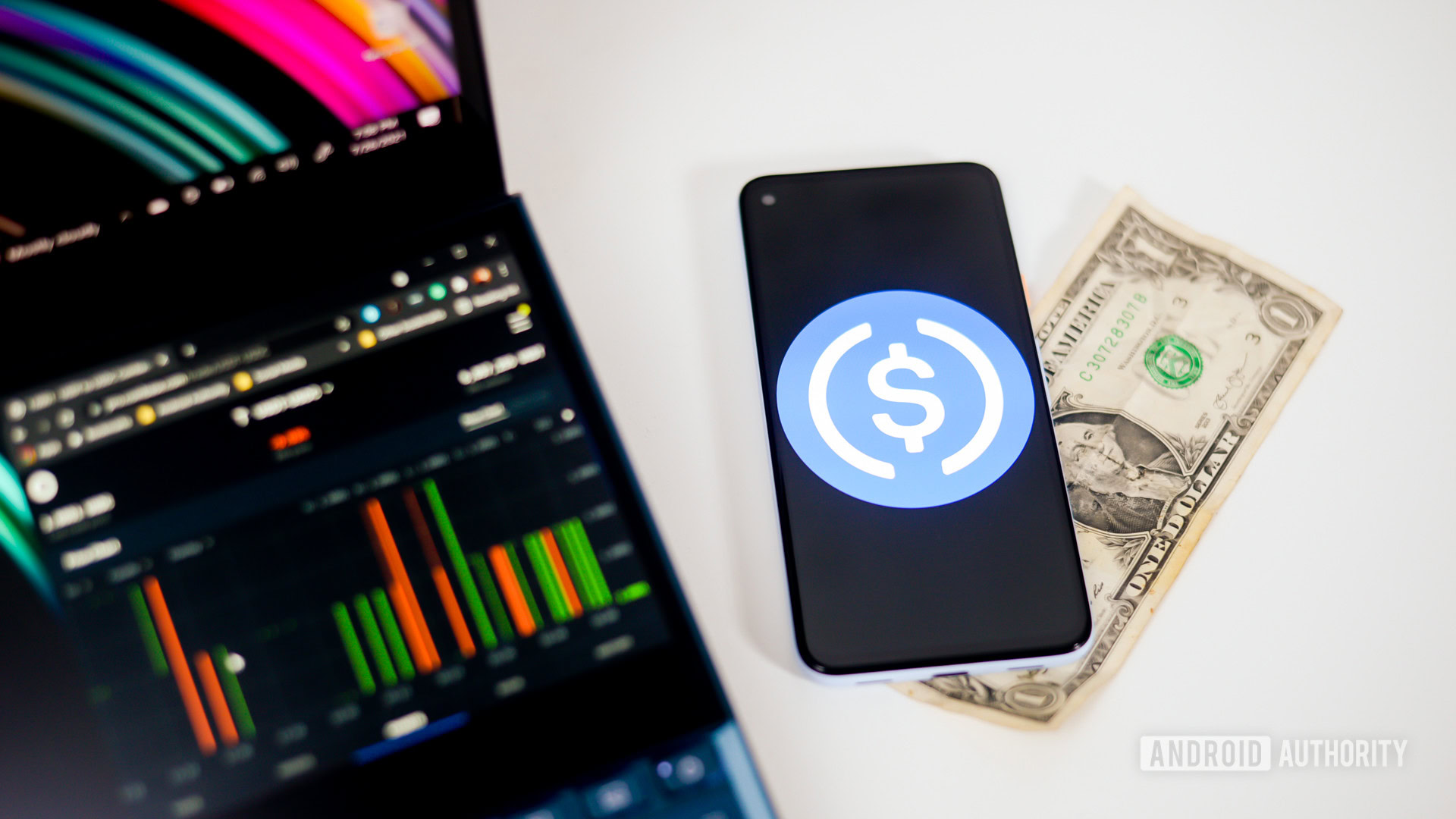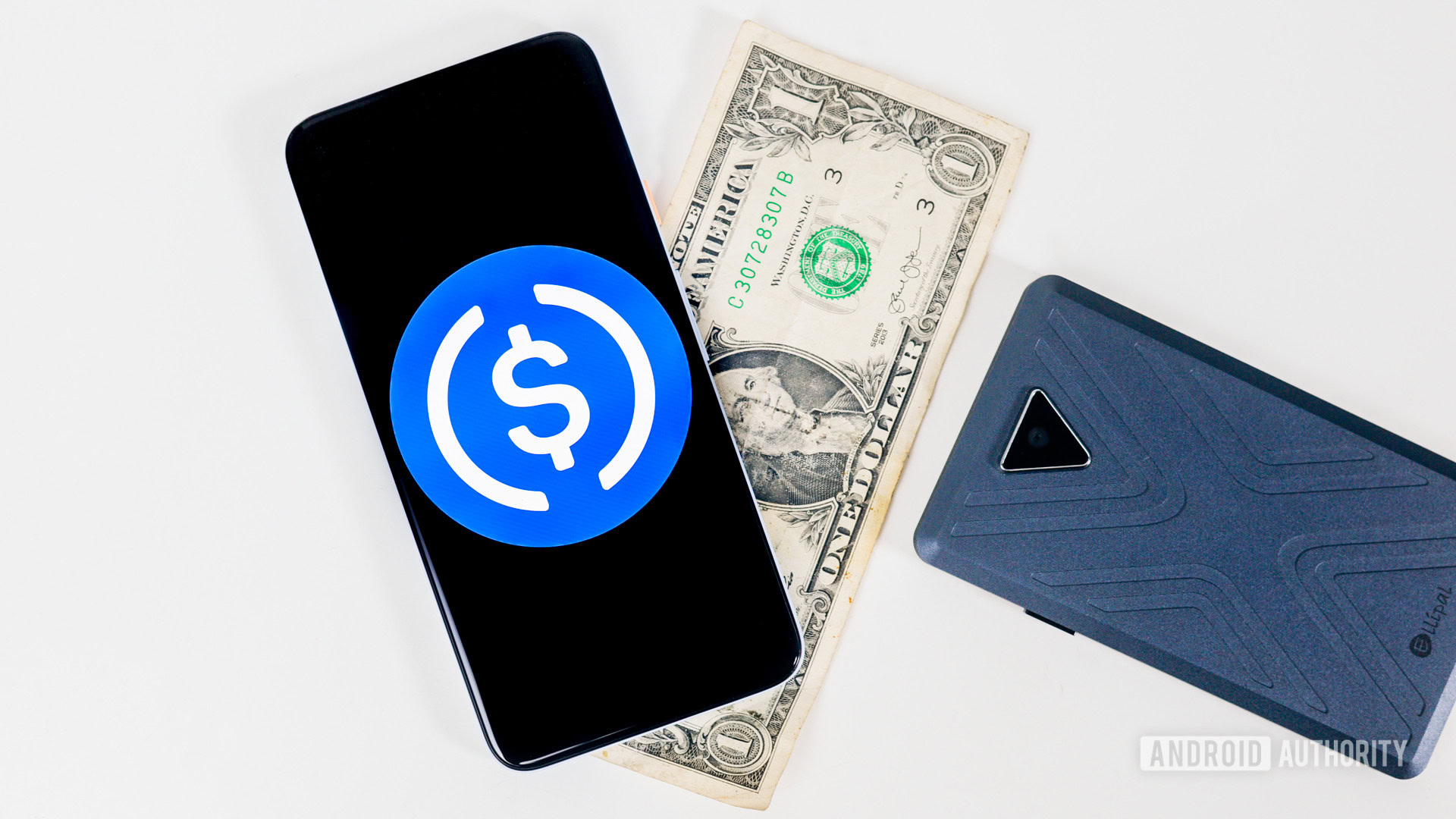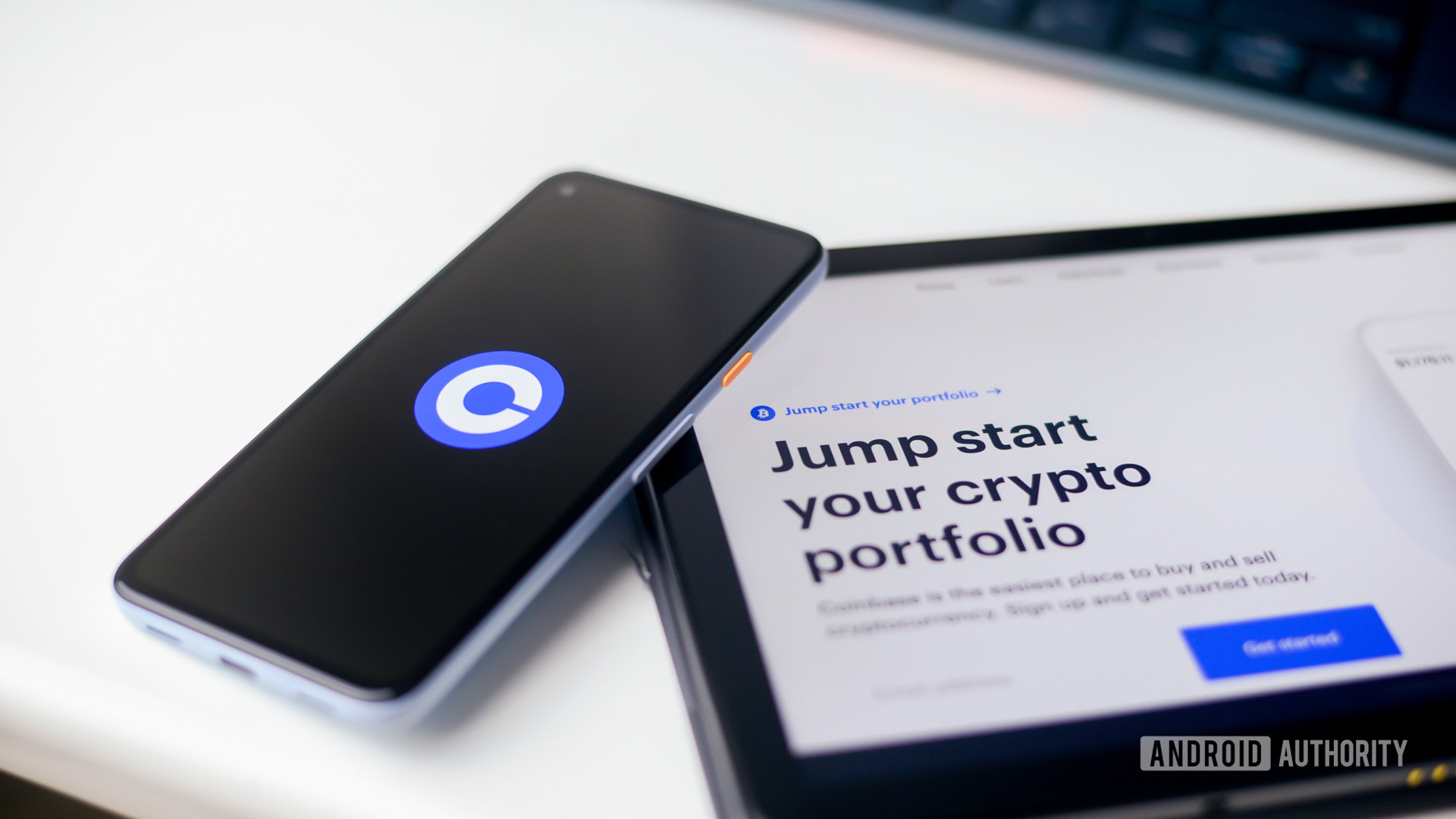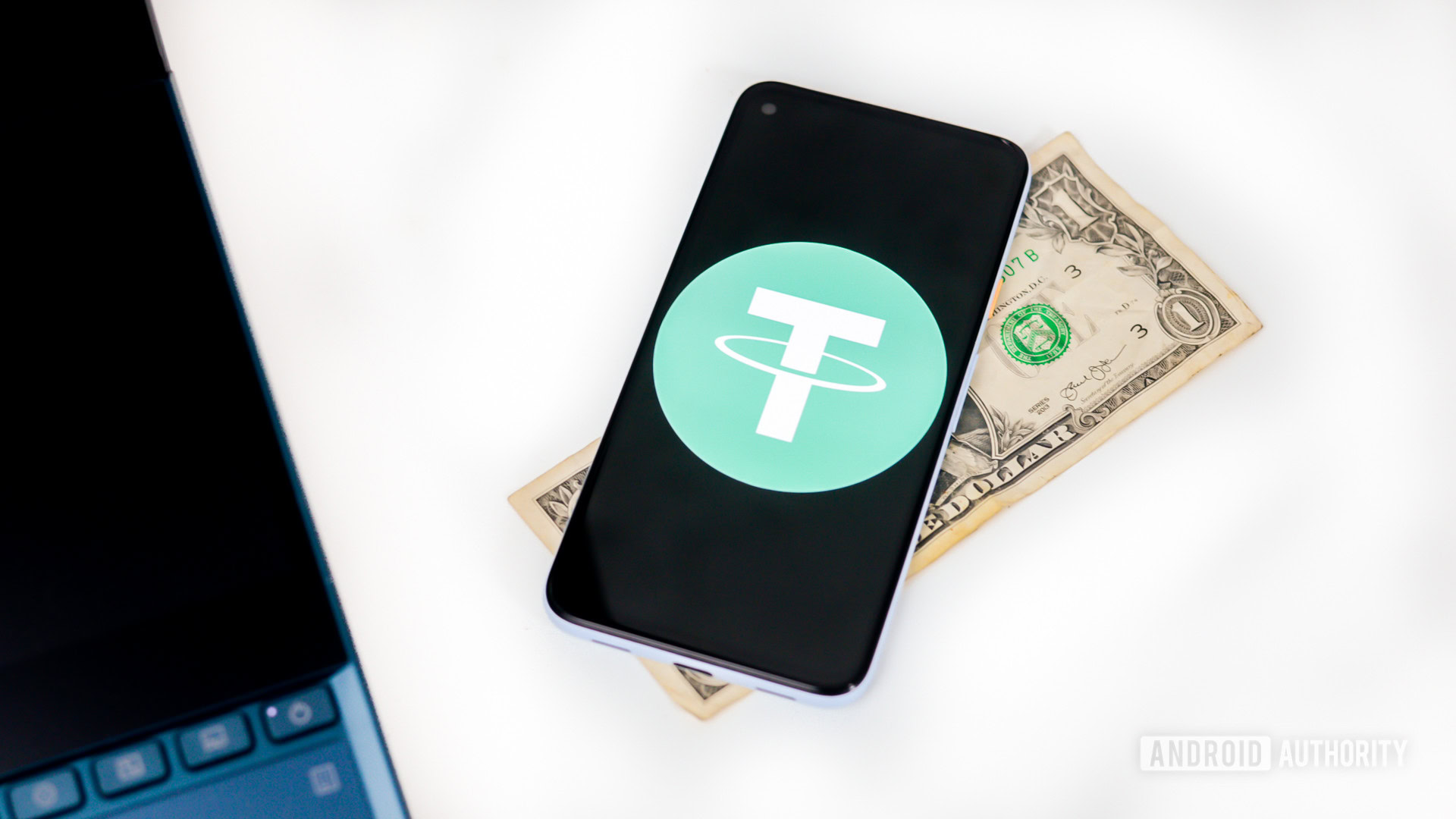Affiliate links on Android Authority may earn us a commission. Learn more.
What is USD Coin? Is USDC a safer stablecoin bet than Tether?
Published onAugust 19, 2022

Cryptocurrencies such as Bitcoin and Ethereum are often praised for their ability to transfer value across international borders. Even though they’re a decade old at this point, almost all digital assets suffer from heavy price fluctuations and volatility. Needless to say, this has significantly hindered their use, appeal, and adoption.
Now, some cryptocurrencies are aiming to fix that problem by offering a digital token that is equivalent to the US dollar. USD Coin (USDC) accomplishes exactly this and is part of a growing class of cryptocurrencies called stablecoins.
While several cryptocurrency tokens are pegged to the dollar, USD Coin has tried to position itself as a more legitimate and trustworthy option. But is it actually any more trustworthy than Tether (USDT) and should you use it?
What is USD Coin and why is it called a stablecoin?

Launched in 2018, USD Coin is a relatively new digital currency that has its value pegged to the US dollar. In case you haven’t heard about stablecoins yet, they are a distinct class of cryptocurrencies.
As their name suggests, stablecoins trade at a constant price. More specifically, they are designed to maintain 1:1 price parity with some other asset — commonly precious metals such as gold and fiat currencies such as the US dollar.
Stablecoins achieve their stability through the backing of a central reserve. This means their price is supported by other assets with universal value. While the first stablecoins maintained pure cash reserves, many have adopted low-risk assets such as treasury bonds as well. Either way, an equivalent amount of money needs to exist before units of the stablecoin can be minted.
Stablecoins trade at a constant price relative to some base asset, often the US dollar.
Circling back to USDC though, the digital currency is backed by a consortium of companies, called Centre. US-based payments giant Circle and cryptocurrency exchange Coinbase jointly founded Centre in 2018. As of 2022, USD Coin is the world’s second-largest stablecoin and is entrenched well into the list of top 20 cryptocurrencies.
Stablecoins such as USDC excel at transferring wealth between different platforms. They are incredibly convenient for traders too, since withdrawing a fiat currency from an exchange takes several hours or even days.
Stablecoins like USDC excel at transferring wealth without the fear of price swings or volatility.
Anyone from anywhere in the world can use USDC as a common and recognizable unit of currency. The alternative would be quoting prices in dozens of local currencies, which would be quite confusing.
For all these reasons, stablecoins such as USDT and USDC have found tremendous success of late.
See also: What is cryptocurrency mining and why is it so important?
How does USDC work?

In theory, you could approach a recognized USD Coin issuer to grant you 100 digital tokens in exchange for 100 US dollars. However, most investors and traders will find it easier to just purchase or trade the stablecoin on a cryptocurrency exchange of their choice, such as Coinbase.
Once you’ve acquired some USDC, you can do several things with it. The stablecoin operator’s white paper, for one, pitches the token as a potentially quick and nearly feeless channel to remit money globally:
An open internet of value exchange can transform and integrate the world more deeply, eventually eliminating artificial economic borders and enabling a more efficient and inclusive global marketplace that connects every person on the planet.
Frequent cryptocurrency traders, meanwhile, prefer USDC for the liquidity it provides while buying and selling various cryptocurrencies.
Coinbase Pro, the company’s full-fledged trading platform, allows traders to exchange dozens of cryptocurrencies against USDC. This allows traders from different regions to trade in a common environment. In addition to offering standardization, this approach also ensures sufficient liquidity and volume — especially in the case of small, less popular tokens.
As for the technical aspects of the token, USD Coin is similar to most other cryptocurrencies in that it uses blockchain technology. More specifically, it is built on top of existing blockchains such as Ethereum and Algorand. USDC’s biggest competitor, Tether, uses a similar approach and is available on even more cryptocurrency networks.
USDC is a token built on top of existing blockchain networks, including Ethereum.
The advantage of using an existing blockchain platform is that stablecoin developers don’t have to reinvent the wheel and create their own network from scratch. The Ethereum platform has also already reached critical mass in terms of support from third-party providers such as wallets. In simpler terms, this means you can store USDC tokens on dozens of existing digital wallets.
Read more: What is Web3? Everything you need to know
USD Coin and the promise of programmable money

In our deep-dive into Ethereum’s fundamentals, we discussed how the blockchain was built to support smart contracts. In a nutshell, anyone can create programmable contracts that run and execute on the Ethereum network. Such contracts are usually perfect for applications involving payments, since the contract terms can be enforced without human intervention.
Traditionally, Ethereum’s own cryptocurrency, ether (ETH), was used for payments connected to these smart contracts. With USDC built right into the Ethereum network, however, developers can simply reprogram their contracts to use the stablecoin instead.
Admittedly, this is a very abstract concept to grasp, so let’s approach it from a practical standpoint instead.
Say, for instance, you sign a smart contract that depends on the outcome of a sporting event. If this contract uses ETH for payment, your final take-home amount may vary depending on the cryptocurrency’s current valuation. A USDC-based contract, on the other hand, would naturally not fluctuate in value since the token always trades at $1. This would leave no ambiguity as to how much value you receive on the day of the contract’s execution.
Until decentralized cryptocurrencies are universally accepted, USDC can help bridge the gap and make digital payments more approachable.
Stablecoins also help alleviate other pain points such as crypto to fiat ramps, which are often slow because of their reliance on banks and financial institutions.
Read more: What is Decentralized Finance (DeFi)?
What sets USDC apart from other stablecoins?
As mentioned previously, USD Coin is backed by two of the largest names in the payments and cryptocurrency exchange industries. Circle and Coinbase are both heavily invested in staying on the good side of global regulators. Somewhat luckily for both of them, most other stablecoin offerings simply cannot boast the same heritage.
It’s not surprising then that USDC’s operator Centre prides itself on being backed by “regulated financial institutions.” The importance of this claim is perhaps best understood if you take a look at USDC’s competition.
Tether (USDT) has garnered widespread criticism over the past few years for its opaque operating structure. Even though Tether Limited claims that it maintains a 1:1 reserve for all USDT tokens minted to date, it evades having its reserves audited by a third party. USDC’s founding members likely recognized this gap in the market and seized the opportunity.
Since USDC’s main claim to fame is its transparency, it provides monthly attestations of its reserves. These are carried out by Grant Thornton LLP, a well-known accounting firm. While not as extensive as a full audit, it still puts Centre ahead of other stablecoin operators in terms of transparency.
To that end, USDC is far less controversial and the scattered doubts over its reserves aren’t nearly as concerning as with Tether.
Buying USD Coin: What you need to know

Stablecoins such as USD Coin are unlike most cryptocurrencies in that they have practically zero value as an investment vehicle. The only exception to that rule is if you live someplace where the US dollar is far more stable than the local currency.
Either way, acquiring USD Coin is pretty simple, provided a local exchange includes a trading pair for it. Notable platforms that carry USDC include Binance, Coinbase, Kraken, Kucoin, and Huobi. If you already hold Tether, it’s worth noting that you can trade your USDT for USDC as well. Just look for a USDT/USDC trading pair.
Most cryptocurrency exchanges will let you trade USDC for USDT or other stablecoins.
The vast majority of USDC tokens are minted on the Ethereum blockchain. To that end, taking self-custody is simple — many cryptocurrency wallets support USDC as well. Our go-to recommendation for safe crypto storage, as always, is to invest in a robust hardware wallet. Failing that, consider using one of our top software wallet picks for smartphones and PCs.
See also: How does a cryptocurrency wallet work?
USDC alternatives worth considering

If USDC’s low acceptance isn’t acceptable to you, it’s worth noting that several competing stablecoins do exist as well. Some strong alternatives to consider include the following:
- Dai: Dai (DAI) was the first decentralized stablecoin to hit the market. Unlike USDC and Tether, it is completely operated by a Decentralized Autonomous Organization (DAO). What this means is that no single company or individual is in control. Instead, users can vote on key decisions. DAI uses a basket of other cryptocurrencies as a reserve and maintains surplus collateral to ensure its peg is not lost if the underlying assets experience volatility.
- True USD: Unlike USDC, True USD (TUSD) is not backed by a cryptocurrency exchange. This allows it to enjoy wider acceptance and exchange support, including some exchanges that do not carry USDC. The company behind TUSD also allows third-party auditors such as Armanino LLP to attest its reserves.
- Gemini USD: As the title suggests here, Gemini USD (GUSD) is a stablecoin offering by the cryptocurrency exchange Gemini. In case you haven’t heard of the exchange, it is backed by the Winklevoss twins — yes, the same ones that took Mark Zuckerberg to court over Facebook nearly two decades ago. Gemini is one of the more regulated exchanges out there, so consider their stablecoin a direct competitor to Coinbase and Circle’s USDC.
Should you use USDC?
So if you need to use stablecoin, should you pick up USDC? Well, it depends. Tether, or USDT, enjoyed a multi-year early mover’s advantage before USD Coin was even conceptualized. Unfortunately, you may find that many exchanges and trading platforms simply don’t support USDC trading. Luckily, though, swapping between USDT and USDC is relatively easy if you ever need to go back and forth.
Also, while USDC definitely boasts a more legitimate background, don’t forget that it is still tied to a commercial operation. This introduces some risk in comparison to truly decentralized cryptocurrencies, which can exist even without the complete absence of a central authority.
What does this mean? In a nutshell, you probably shouldn’t put your life savings in USDC — or any centralized stablecoin for that matter. The risk of companies going bankrupt is a tangible one in this day and age, and if that were to happen, the stablecoin could lose its peg. Waning public trust is another factor that could mar a stablecoin’s stability, but that has yet to happen in the stablecoin industry.
For intermittent trading and daily use though, USD Coin is certainly one of the most trustworthy stablecoin options out there.
Read more: How to buy cryptocurrency: A definitive guide to cryptocurrency investing
FAQ
Cryptocurrency transaction fees vary significantly depending on a number of factors. Assuming you’re transferring USDC on the Ethereum network, you can expect to pay anywhere from a few cents to a couple of dollars on a normal day. However, network congestion may push this number higher. Either rely on your wallet to suggest the right fee for the circumstances or check out GasNow for live estimates.
Since USDC is not volatile, it works well as a payment method for goods and services. You can use USD Coin to pay for gift cards on Bitrefill, electronics on Newegg, or any other merchant that supports BitPay.
Given the suspiciously high interest rates, it’s natural to assume that you’re taking on a certain degree of risk while lending your stablecoin holdings. And you would be somewhat correct. Unlike bank accounts or other investment instruments, cryptocurrency deposits are not guaranteed or insured by central authorities and governments.
While lending institutions require heavy collateral from borrowers to offset the risk of defaults, there is no transparency or guarantee to the loans they issue. Moreover, several lending platforms have gone bankrupt of late, making cryptocurrency lending highly risky.